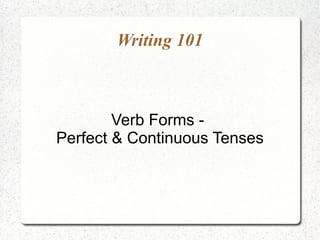
Ll upper pri a aspects of verb
- 1. Writing 101 Verb Forms - Perfect & Continuous Tenses
- 2. Learning Objectives Understand how verbs change as a result of how an action is done. Use memory aids to help in remembering different aspects of time.
- 3. Introduction A sentence's meaning changes when the aspects of verb change. 1) He is walking to school. (now still walking) 2) He has walked to school. (reached after a while) 3) He has been walking to school. (still walking after a while) In these 3 examples, they all belong to an action – 'walk' – in the present moment. However, the manner in which the action takes place is different.
- 4. Aspects of Verb These aspects are known as Continuous ('ing' form), Perfect ('ed' form) and Perfect Continuous ('been' + 'ing' form) respectively. 1) He is walking to school. (now still walking) 2) He has walked to school. (reached after a while) 3) He has been walking to school. (still walking after a while) Even though they are all referring to present actions – with present tenses 'is' and 'has' – the aspects of verbs and hence, the meanings are different.
- 5. How to remember them? These 3 aspects of verbs are easily remembered when you use memory aids (or mnemonic devices). Perfect sounds like 'fat' so extend your arms wide, as if hugging someone (hugging a 'fat' man). This verb form describes a completed action over a period (fat) of time. Continuous ends with 's' so do a 'chopping' action on an imaginary snake head (chopping snake head). This verb form describes an ongoing action at the moment (chop) in time.
- 6. Examples We will see some examples: 1) 100,000 people have attended Michael Buble's concert so far. 2) Alan was studying when the bell rang. have attended – completed over a period of time was studying – ongoing at moment of speech. Note that perfect and continuous tenses are fixed with has/have/had + 'ed' and is/are/was/were + 'ing' forms respectively.
- 7. Learning Activity Say what aspects of verb – perfect or continuous – have been used in these sentences. 1) He has had his lunch already. 2) The lesson has ended and it's time to go home. 3) She is walking to school now. Q: What are the key word/s that show you the aspects?
- 8. Learning Activity Answers The aspects of verbs and the key words that help show them are highlighted. 1) He has had his lunch already. (perfect) 2) The lesson has ended and it's time to go home. (perfect) 3) She is walking to school now. (continuous)
- 9. Discussion What is a verb aspect as compared to its tenses? What are the 2 aspects discussed in this topic? What do they indicate? How do we remember them?
- 10. In Summary A verb aspect describes how an action is done as compared to verb tenses describing when it is done. The 2 aspects discused are perfect and continuous. They described completed action over a prolonged period and an ongoing action at the moment of speech. They are remembered by a 'hugging fat man' for perfect and 'chopping snake head' for continuous
